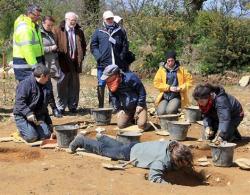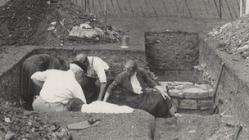INSTITUT SUPERIEUR D'ANTHROPOLOGIE
INSTITUTE OF ANTHROPOLOGY
ONLINE COURSES / COURS A DISTANCE
INSCRIPTION 2012 / Session III : Juillet 2012
REGISTRATION 2012 / Term III : July 2012
FRANCE –  Kroas-Lesneven - La semaine dernière, une douzaine d'étudiants en archéologie et en histoire de l'art, a participé à de nouvelles fouilles sur le site archéologique de Kroas-Lesneven. Ils ont fouillé méticuleusement une série de fosses dans lesquelles ils ont découvert des vestiges d'une civilisation néolithique pouvant dater de 4 000 ans avant Jésus-Christ. Deux sites de périodes très différentes et inconnues avant l'intervention ont ainsi été découverts. Le premier, une petite nécropole contenant cinq tombes, de la fin de l'époque gallo-romaine a pu être entièrement fouillé. Le second, datant du Néolithique moyen, nécessitait une intervention plus approfondie. Dans un sol schisteux, dur et compact, de nombreux vestiges ont été mis à jour. La découverte de trous de poteaux, de foyers - reconnaissables aux pierres rougies -, de silex, de tessons de céramique, de polissoirs et d'une hache en dolérite a suscité l'admiration des étudiants, fiers de leurs précieuses trouvailles.
Kroas-Lesneven - La semaine dernière, une douzaine d'étudiants en archéologie et en histoire de l'art, a participé à de nouvelles fouilles sur le site archéologique de Kroas-Lesneven. Ils ont fouillé méticuleusement une série de fosses dans lesquelles ils ont découvert des vestiges d'une civilisation néolithique pouvant dater de 4 000 ans avant Jésus-Christ. Deux sites de périodes très différentes et inconnues avant l'intervention ont ainsi été découverts. Le premier, une petite nécropole contenant cinq tombes, de la fin de l'époque gallo-romaine a pu être entièrement fouillé. Le second, datant du Néolithique moyen, nécessitait une intervention plus approfondie. Dans un sol schisteux, dur et compact, de nombreux vestiges ont été mis à jour. La découverte de trous de poteaux, de foyers - reconnaissables aux pierres rougies -, de silex, de tessons de céramique, de polissoirs et d'une hache en dolérite a suscité l'admiration des étudiants, fiers de leurs précieuses trouvailles.
http://www.ouest-france.fr/actu/actuLocale_-De-nouvelles-fouilles-archeologiques-a-Kroas-Lesneven-_29027-avd-20120502-62745719_actuLocale.Htm
ROYAUME UNI –  Glastonbury - New research on glass fragments found at Glastonbury Abbey in the 1950s reveals the earliest archaeological evidence of glass-making in Britain. Researchers from the University of Reading carried out radiocarbon dating on finds from the digs. Clay crucibles and pieces of vivid blue-green window glass were tested. The results show the pieces date from the 680s and are likely to be associated with a major rebuilding of the abbey by King Ine of Wessex. The research team believes specialist glass workers came from France to work at Glastonbury. Analysis of the glass is now being carried out to find out where the source materials came from. Extensive remains of five glass furnaces have also been identified. Prof Roberta Gilchrist from the Department of Archaeology said: "The research project reveals new evidence for the early date of the monastery at Glastonbury and charts its development over one thousand years, from the 6th century to its dissolution in the 16th century." Glass-making at York and Wearmouth is recorded in historical documents in the 670s but Glastonbury provides the earliest and most substantial archaeological evidence for glass-making in Saxon Britain.
Glastonbury - New research on glass fragments found at Glastonbury Abbey in the 1950s reveals the earliest archaeological evidence of glass-making in Britain. Researchers from the University of Reading carried out radiocarbon dating on finds from the digs. Clay crucibles and pieces of vivid blue-green window glass were tested. The results show the pieces date from the 680s and are likely to be associated with a major rebuilding of the abbey by King Ine of Wessex. The research team believes specialist glass workers came from France to work at Glastonbury. Analysis of the glass is now being carried out to find out where the source materials came from. Extensive remains of five glass furnaces have also been identified. Prof Roberta Gilchrist from the Department of Archaeology said: "The research project reveals new evidence for the early date of the monastery at Glastonbury and charts its development over one thousand years, from the 6th century to its dissolution in the 16th century." Glass-making at York and Wearmouth is recorded in historical documents in the 670s but Glastonbury provides the earliest and most substantial archaeological evidence for glass-making in Saxon Britain.
http://www.bbc.co.uk/news/uk-england-somerset-17989094
Rep. TCHEQUE –  Prague - The Czech Archaeological Society (ČSP) has announced the discovery of the remains of houses dating back more than 7,500 years in the Prague district of Bubeneč, along with a burial site there that is about half as old. “We have managed to unearth impressions of wooden supporting structures of so-called long houses, typical of the Neolithic period,” said ČSP director and researcher Radek Balý. Long houses are typical of the Linear Pottery culture in much of Europe at the time. Over the years, Bubeneč has proved fertile hunting grounds for finds from the early Stone Age up through the Bronze Age. Balý said the area had been continuously populated for many thousands of years. Last April, Czech archaeologists working in Bubeneč discovered what the international tabloid media came to call the grave of a “gay cavemen” — in fact a unique late Stone Age grave perhaps of a transsexual or “third gender” man dating from between 2500-2800 BC and the era of the so-called Corded Ware culture in the Czech Republic.
Prague - The Czech Archaeological Society (ČSP) has announced the discovery of the remains of houses dating back more than 7,500 years in the Prague district of Bubeneč, along with a burial site there that is about half as old. “We have managed to unearth impressions of wooden supporting structures of so-called long houses, typical of the Neolithic period,” said ČSP director and researcher Radek Balý. Long houses are typical of the Linear Pottery culture in much of Europe at the time. Over the years, Bubeneč has proved fertile hunting grounds for finds from the early Stone Age up through the Bronze Age. Balý said the area had been continuously populated for many thousands of years. Last April, Czech archaeologists working in Bubeneč discovered what the international tabloid media came to call the grave of a “gay cavemen” — in fact a unique late Stone Age grave perhaps of a transsexual or “third gender” man dating from between 2500-2800 BC and the era of the so-called Corded Ware culture in the Czech Republic.
http://www.ceskapozice.cz/en/news/society/archaeologists-find-early-stone-age-houses-prague
FRANCE – Toulousain - La violence est aujourd'hui particulièrement médiatisée. Pourtant, les violences graves (homicides) n'ont cessé de décroître, essentiellement par autocontrôle des pulsions agressives et désarmement généralisé des populations. Notre civilisation est globalement apaisée, contrairement aux idées actuelles. En 2009, en France, le taux d'homicides volontaires était de 1,78 pour 100 000 habitants contre 10 pour 100 000 entre 1600 et 1650. Qu'en était-il au Moyen Âge ? Pour approcher ce phénomène en Lauragais, les sources sont assez nombreuses. En effet, les consuls, dans de nombreuses localités, exercent la justice criminelle. Les coutumes évoquent une violence, celle que la population, peut-être, redoute. Marie-Claude Marandet a confronté celle-ci avec la violence réelle qui peut être approchée par les grâces accordées par le roi suite à un délit, les dépositions des témoins à l'instruction et les dépositions faites à l'audience devant les cours criminelles. Il en subsiste plusieurs pour Castelnaudary et Mireval dans la deuxième moitié du XIVe siècle. Contrairement à l'idée trop répandue d'un Moyen Âge sanguinaire, les sources rapportent le plus généralement des faits divers et l'exercice d'une justice cherchant souvent l'apaisement : compensations, arrangements entre parties, lettres de rémission… Cependant les pauvres et les étrangers sont des coupables désignés, alors que les criminels insérés dans la société sont favorisés. La gradation des peines est fonction de l'arme utilisée et de la qualité de la victime. Ainsi le viol se paie plus ou moins cher selon qu'il est commis sur une jeune fille vierge, une femme mariée ou une prostituée. À la fin du Moyen Âge, la société est très procédurière et le tribunal de Mireval reçoit par exemple une plainte pour le vol d'une poule, d'un chevron.
http://www.ladepeche.fr/article/2012/05/06/1346799-bram-la-violence-au-moyen-age.html
ROYAUME UNI –  Carwynnen Quoit - To the untrained eye, it might look like a pile of rubble dumped unceremoniously in the middle of a forgotten field. But to archaeologists, the giant stones represent a portal into the past which could unlock the secrets of life and death in Cornwall 5,000 years ago. Permission has just been granted for excavations at the collapsed Carwynnen Quoit on the outskirts of Praze-an-Beeble, which archaeologists believe could provide them with a fascinating glimpse into the past. The quoit, one of many in the west of Cornwall, is thought to date from the late Neolithic or early Bronze Age. In its prime, it would have consisted of large upright slabs covered by a single, massive capstone. The distinctive flat-topped structure is known to have been a feature of the field for thousands of years. In 1834 it collapsed, but was re-erected, only to fall apart once more in 1967, a state it has remained in ever since. Carwynnen is one of about a dozen megalithic tombs that survive in Cornwall. Their exact purpose remains a mystery, as does the precise date of their creation. It is believed quoits were built as tombs for complete bodies and when the one at West Lanyon collapsed two centuries ago excavation revealed a number of skeletons. The most recent deposit at Sperris Quoit near Zennor was found to have cremated remains from 1,500BC, though this is thought to indicate only the date of its last use. Some archaeologists believe the structures were left partially open rather than being completely covered with earth, and there is evidence that bones were sometimes removed and returned or rearranged.
Carwynnen Quoit - To the untrained eye, it might look like a pile of rubble dumped unceremoniously in the middle of a forgotten field. But to archaeologists, the giant stones represent a portal into the past which could unlock the secrets of life and death in Cornwall 5,000 years ago. Permission has just been granted for excavations at the collapsed Carwynnen Quoit on the outskirts of Praze-an-Beeble, which archaeologists believe could provide them with a fascinating glimpse into the past. The quoit, one of many in the west of Cornwall, is thought to date from the late Neolithic or early Bronze Age. In its prime, it would have consisted of large upright slabs covered by a single, massive capstone. The distinctive flat-topped structure is known to have been a feature of the field for thousands of years. In 1834 it collapsed, but was re-erected, only to fall apart once more in 1967, a state it has remained in ever since. Carwynnen is one of about a dozen megalithic tombs that survive in Cornwall. Their exact purpose remains a mystery, as does the precise date of their creation. It is believed quoits were built as tombs for complete bodies and when the one at West Lanyon collapsed two centuries ago excavation revealed a number of skeletons. The most recent deposit at Sperris Quoit near Zennor was found to have cremated remains from 1,500BC, though this is thought to indicate only the date of its last use. Some archaeologists believe the structures were left partially open rather than being completely covered with earth, and there is evidence that bones were sometimes removed and returned or rearranged.
http://www.thisiscornwall.co.uk/Ancient-stones-tell-quoit-story/story-15989334-detail/story.html